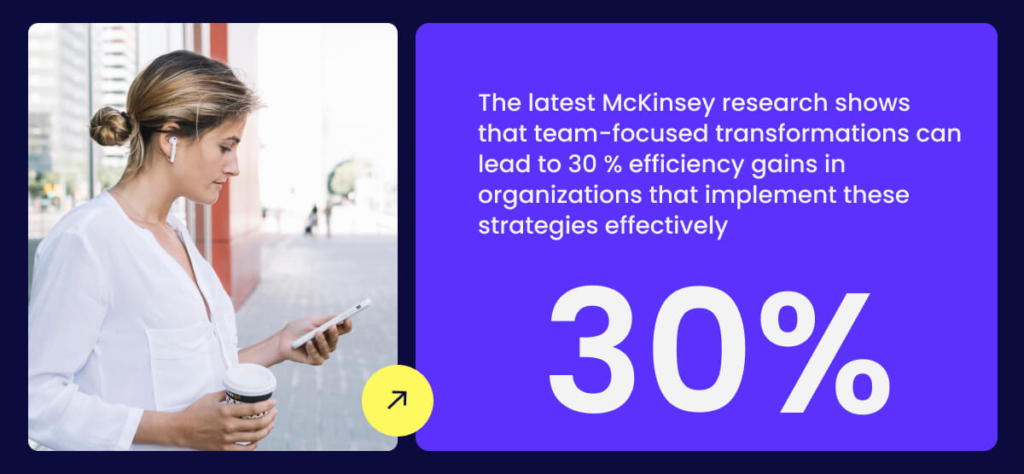Many training methods prioritize individual learning, even in traditional classroom settings, where success is measured by personal achievement.
Team training, however, is a type of employee training that shifts the focus to how a group can collectively build knowledge and skills. It is particularly effective when colleagues need to develop the same competencies, whether technical hard skills, interpersonal soft skills, or a mix of both.
Team training differs from team building and team development, offering distinct benefits in various workplace scenarios.
While all three approaches enhance team performance, team training equips employees with the skills to work more efficiently and adapt to evolving business demands.
The latest McKinsey research shows that team-focused transformations can lead to 30 % efficiency gains in organizations that implement these strategies effectively.

This article will explore team training, how it compares to other group learning approaches, the best implementation methods, and when it is most effective.
What is team training?
Team training is any training that involves a group learning together. This can include education on industry-specific processes, soft skills development to improve teamwork, activities that strengthen collaboration, and briefings on the latest procedures.
The primary goal of team training is to enhance a team’s collective skills, knowledge, and performance. Sometimes, team training also aims to boost morale and improve employee experience, particularly in team-building initiatives.
While it is especially crucial in industries that rely on expertise and collaboration—such as healthcare, aviation, and engineering—its principles apply to organizations across all sectors.
What’s the difference between team training, building, and development?
Team training, team building, and team development are related but distinct concepts, each with different goals and practices:
- Team training enhances specific job-related skills and knowledge, ensuring teams can perform their tasks effectively.
- Team building focuses on strengthening interpersonal relationships, communication, and collaboration through experiential activities, fostering a positive team culture. It is a type of team training.
- Team development (also called group development) takes a broader approach, examining team dynamics, stages of team growth, and how teams adapt to change.
Each plays a valuable role, but this article will focus specifically on team training.
What are the different methods of team training?

This section will introduce some of the most important team training methods. They are:
- Cross-training
- Team retreats
- Workshops
- Simulation
- Self-guided eLearning
As discussed, some of these methods are also relevant for individual skills training. However, their adaptation can benefit the particular needs of training teams, in which collaborative skills, communication, and cohesion among team members are important.
Cross-training
In a team training context, cross-training refers to providing team members with knowledge and skills beyond their primary roles or areas of expertise. It is a type of collaborative training in which one team member supports another in a niche area of expertise.
Cross-training ensures that everyone in a team has a basic understanding of the tasks and responsibilities involved with all functions within the team. This approach promotes flexibility and adaptability within the team, allowing members to step into different roles when needed and fostering a more collaborative and resilient team structure.
Cross-training is particularly valuable in dynamic environments where tasks and responsibilities may shift. It ensures that the team can effectively respond to changes and challenges.
Team retreats
A team retreat is a focused off-site opportunity for intensive training and development. Other names for this activity include “offsite,” “away day,” or “immersion.”
Retreats are defined as sustained team training away from the normal work environment for a day, week, or more. Facilitators can use various teaching methods within the retreat environment, including workshops, discussions, team-building exercises, etc.
Retreats are often used to escape from the eLearning techniques that are so common in today’s workplace. The change of environment encourages reflection, open dialogue, and networking, contributing to renewed energy and motivation among team members.
A training retreat will usually have a set of complementary goals. Those goals include team-building, targeted skills development, and soft skills training.
Workshops
“Workshop” is a general term for various training interventions. Most workshops will involve clear objectives, a structured approach, and some element of simultaneous participation, even if this means everyone is in one place at once.
In practice, a workshop may include:
- Managerial presentations
- Discussion activities
- Team problem-solving tasks
- Software walk-throughs
- Training simulations
Workshops ensure that all relevant staff know current information, skills, and the company vision. Other goals of training workshops include networking, feedback, and problem-solving.
Simulation training
Simulation training can support team training for the skills, knowledge, and capabilities required by the most demanding business situations. Simulation enables high-pressure business scenarios to be re-created realistically without the risks involved. It also supports team-building in domain-specific ways.
Some of the particular types of team simulation include:
- Tabletop simulations involve participants strategizing and discussing their responses to simulated scenarios in a collaborative, discussion-based format without real-time actions.
- In-situ simulation training occurs in the workplace or a closely replicated setting, allowing participants to practice and refine their skills in a realistic environment.
- Role-playing simulations require participants to take on specific roles or characters, simulating real-world interactions in an engaging and interactive way.
These activities all help individual staff members understand how they contribute to teams and develop their particular skills in decision-making, taking responsibility, and communication. Simulations are also used for personal skill development in many areas.
Self-guided eLearning
Unlocking a team’s full potential often depends on individual members taking charge of their own learning. In these cases, self-guided eLearning is a valuable tool for training managers.
It allows team members to explore courses, modules, and educational materials at their own pace, typically through digital platforms or learning management systems.
Some of the tasks that are most useful for eLearning include:
- Health and safety training
- Compliance training
- Re-accreditation for technical training
- Onboarding training for new team members
- Cybersecurity awareness training
- Training in new software (especially during digital transformations)
The team needs training to perform effectively in these scenarios, but independent study is often the most efficient method. Contextual learning systems deliver relevant information in real-time, while digital adoption platforms streamline the learning of new tools. Learning experience platforms personalize training, ensuring each team member develops the necessary skills at their own pace.
Together, these technologies create a flexible and efficient training environment that boosts both individual and team performance.
What are the practical applications of team training?
This section will examine some scenarios where team training can be especially valuable. They include:
- Conflict resolution training
- Coordination training
- Team knowledge training
- Team building.
These are key areas for team training in any organization:
Conflict resolution training
Conflict management training equips team members with essential skills to handle tense situations. Understanding different conflict resolution styles, fostering open dialogue, and addressing personal differences help teams strengthen relationships and improve collaboration.
Training focuses on managing diverse perspectives, promoting active listening, and applying effective communication techniques.
Two key elements of team conflict resolution training are resolving personal differences and building effective dialogue:
- Resolving personal differences is critical for maintaining team well-being and productivity. Training in communication, active listening, and tailored techniques helps team members navigate disagreements and misunderstandings.
- Effective dialogue is essential for mediating conflicts and preventing escalation. This training enhances organizational culture by emphasizing open communication, active listening, and valuing diverse perspectives.
In 2025, Gartner’s Future of Work trends report highlights the importance of team inclusion and belonging. Organizations recognize that a culture where diverse perspectives are valued leads to better collaboration and more creative solutions.
In team settings, addressing conflicts becomes an opportunity to strengthen relationships and improve communication. As team members feel more supported, they are more likely to contribute openly, directly impacting performance and problem-solving.
Coordination training (CRM training)
CRM training, or Crew Resource Management training, is a specialized training program in high-stakes industries. It enhances team communication, collaboration, decision-making, and teamwork skills to improve safety and operational effectiveness.
In CRM training, teams will learn to coordinate human resources, technology, time, information, leadership, and training. Some of the teams where this is especially relevant include:
- Aviation
- Healthcare
- Maritime
- Military
- Emergency services
- Rail transportation
- Hospitality and tourism
Methods like simulations and drills give teams the hands-on experience they need to apply their skills practically. Continuous reinforcement through regular refresher courses and debriefing sessions ensures that the principles of coordination and effective teamwork become ingrained in the team’s operational culture.
Remember to distinguish CRM training from customer relationship management (CRM) software.
Team knowledge training
Building team knowledge is vital to improving communication, facilitating cross-training, and helping all employees operate at the highest possible level.
This can be achieved through soft skills training, especially in communication. However, team knowledge training can focus on specific tools, techniques, and mindsets that enable a free-flowing exchange of information.
Team knowledge training could focus on the following:
- Workshops about information boards
- Guided eLearning for key project management tools
- Simulation training in scenarios that benefit from knowledge exchange
- Seminars on best practices, including expert speakers
For some people, knowledge transfer is a natural activity. However, training in this area can quickly improve the working environment and overall team business outcomes.
Team building
As mentioned above, we see team building as one specific type of team training intervention.
Team building enhances collaboration, communication, and cohesion among team members. It fosters positive relationships, improves trust, and develops a shared understanding of common goals. It does not need to create domain-specific knowledge.
Team building can include a huge range of activities. For example:
- Outdoor adventure activities
- Escape room challenges
- Team-building games
- Icebreaker activities
- Problem-solving exercises
- Collaborative art projects
Enhanced team retreats and away days can be very effective ways of building better teams. Investing in team building means organizations can create a more supportive and collaborative work environment, leading to improved teamwork, higher morale, and increased productivity.
Training teams for a productive future
Team training is a powerful tool for improving organizational productivity and performance.
While some argue for shifting to peer-to-peer accountability, research and real-world examples show that traditional training methods still offer tangible benefits.
Studies have proven that structured team training directly contributes to better performance, equipping employees with the skills they need to excel in their roles.
Team training does more than develop technical skills—it cultivates better communication, improves problem-solving, and encourages collaboration.
Leaders who invest in training see stronger team dynamics and enhanced output as employees work more effectively together. Training also supports adaptation to challenges as team members learn to navigate complex situations collectively.
While new methods and ideas may shape future strategies, the tried-and-tested team training approach continues to deliver consistent results. Businesses strengthen their foundation by investing in team development, creating a more productive and cohesive workforce that can handle any challenge.
FAQs
An effective team is built on key qualities that drive success:
- Collaboration: Working together towards shared goals
- Clear communication: Transparent exchange of ideas
- Trust: Confidence in one another
- Respect: Valuing team members
- Flexibility: Adapting to change
- Problem-solving skills: Navigating challenges.
Accountability: Taking ownership of tasks.
The 5 Cs guide effective team interactions:
- Communication: Open and clear dialogue.
- Collaboration: Working together towards common goals.
Commitment: Dedication to team success. - Competence: Skills and expertise.
- Character: Integrity and respect for others.
The 4 P’s are vital for building a successful team:
- Purpose: A shared goal to unite the team
- Process: Clear steps to reach objectives
- People: Team members with diverse skills
- Performance: Ongoing evaluation and improvement

